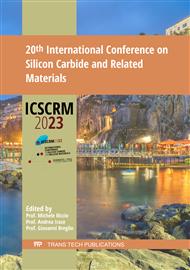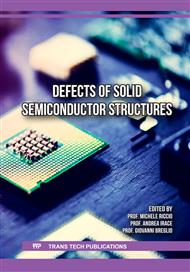[1]
C. Codreanu et al, Mater Sci Semicond Process 3, 137-142 (2000).
Google Scholar
[2]
P. G.Neudeck et al, Solid-State Electronics 42(12), 2157-2164 (1998).
Google Scholar
[3]
P. Bergmanet al, Mater. Sci. Forum 353-356, 299-302 (2001).
Google Scholar
[4]
A. K. Agarwal et al, IEEE Electron Device Lett. 28, 587-589 (2007).
Google Scholar
[5]
J. W. Sun et al, Journal of Applied Physics 111(11), 113527 (2012).
Google Scholar
[6]
R. Singh and M. Pecht, IEEE Industrial Electronics Magazine, 2, 19-31, (2008).
Google Scholar
[7]
Lely, A.J., Darstellung von Einkristallen von Siliziumcarbid und Beherrschung von Art und Menge der eingebauten Verunreinigungen. Ber. Dtsch. Keram. Ges. 32: 229-231(1955).
Google Scholar
[8]
D. R. Hamilton, The Growth of Silicon Carbide by Sublimation, in Silicon Carbide, in A High Temperature Semiconductor, J.R. Connor and J. Smilestens, Editors, Oxford: Pergamon. 45-51 (1960).
Google Scholar
[9]
V. P. Novikov and V.I. Ionov, Production of Monocrystals of Alpha Silicon Carbide. Growth Crystal 6, 9-21 (1968).
Google Scholar
[10]
Y. M. Tairov and V.F. Tsvetkov, Journal of Crystal Growth 43(2), 209-212 (1978).
Google Scholar
[11]
X.R. Huang et al, J. Appl. Cryst. 32, 516-524 (1999).
Google Scholar
[12]
M. Dudley et al, J. Phys. D: Appl. Phys. 32, A139-A144 (1999).
Google Scholar
[13]
T. Zhou et al, MRS Online Proc. Libr. 1494, 121-126 (1999).
Google Scholar
[14]
T. Zhou et al, Journal of Elec Materi 43, 838-842 (2014).
Google Scholar
[15]
Q. Cheng et al, J. Electron. Mater. 50, 4104-4117 (2021).
Google Scholar
[16]
B. Raghothamachar et al, J. Cryst. Growth 544, 125709 (2020).
Google Scholar
[17]
H. Peng et al, J. Appl. Cryst. 55, 544-550 (2022).
Google Scholar
[18]
Q. Cheng et al, Defect and Diffusion Forum 426, 57-64 (2023).
Google Scholar
[19]
Q. Cheng et al, Materials Science in Semiconductor Processing 174, 108207 (2024).
Google Scholar
[20]
M. R. Surowiec and B. K. Tanner, Philos. mag., A 55:6, 791-805 (1987).
Google Scholar
[21]
H. Wang, Studies of Growth Mechanism and Defect Origins in 4H-Silicon Carbide Substrates and Homoepitaxial Layers. 2014. Stony Brook University, PhD dissertation.
Google Scholar
[22]
K. Kamei et al, Mater. Sci. Forum, 717-720, 45-48 (2012).
Google Scholar
[23]
T. Ailihumaer et al, J. Electron. Mater., 50, 3258-3265 (2021).
Google Scholar
[24]
Y Chen et al, Mater. Sci. Forum 556-557, 231-234 (2007).
Google Scholar



